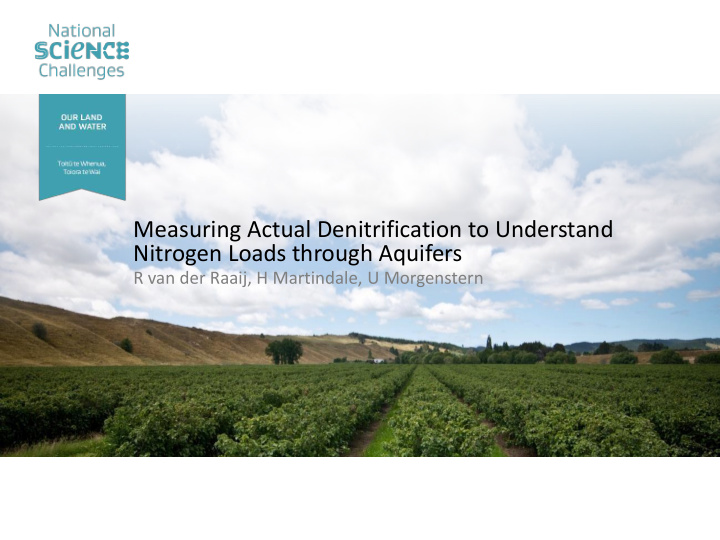



Measuring Actual Denitrification to Understand Nitrogen Loads through Aquifers R van der Raaij, H Martindale, U Morgenstern
Goal Develop and validate an improved method for quantifying the extent of denitrification that actually occurs in groundwater systems, based on measurement of ‘excess N2’. Purpose Knowledge of where denitrification occurs will help land use managers plan where intensive land use can/can’t be carried out – leading to reduced environmental impacts on our land and waterways.
Nitrate Nitrate is the most ca. 40% of long-term groundwater pervasive monitoring sites show above- groundwater natural concentrations contaminant Denitrification is a natural process for nitrate remediation NO3 → NO2 → NO (g) → N 2 O (g) → N 2 (g)
Why do we care? Surface water • Increased nitrogen in surface waterways can promote the growth of periphyton and degrading aquatic habitat and recreational values • Elevated levels of nitrate and ammoniacal nitrogen can be toxic to fish and other animals. Groundwater ‒ High levels of nitrogen in groundwater sourced drinking water can affect human health. • High levels of nitrate can pose a risk to babies less than six months who are formula fed and the unborn foetus of pregnant women. Adults with specific rare metabolic disorders may also be at risk • Groundwater that is rich in nitrate has the potential to elevate nutrient levels in the surface water it drains into causing the problems listed above.
Current Research: 1. Groundwater dating techniques (Tritium, SF6, Halon1301, 14C) 2. Indicators for source of groundwater recharge (isotopes, dissolved gases) 3 Techniques for quantifying groundwater storage and rates of recharge and flow 4. Link of groundwater flow metrics with geology 5. Groundwater - surface water interaction
Current Research: 1. Isotope indicators for source and fate of nitrate and ammonium, from soil to freshwater impacts 2. Nitrogen, carbon and biomarker dynamics in soil and sediment
Dual isotope identification of nitrate sources and sinks • Currently we can use natural isotope ratios to identify the N source. • These ratios can be distorted by denitrification. • Quantifying denitrification will allow for more accurate determination of source.
Excess nitrogen from denitrification NO3 → NO2 → NO (g) → N 2 O (g) → N 2 (g)
Next step quantify the extent of denitrification in field trials (2018) collaboration • Waikato Region • Chemistry conditions/pathways • Approx. 30 sites for denitrification to occur • Cross calibration on 15 sites in the Horizons Region and 15 sites in the Waikato Region
Thank you
Recommend
More recommend